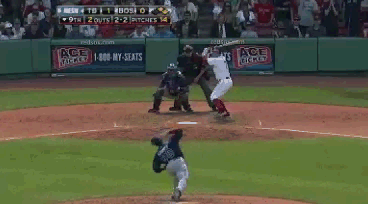Did Jose Molina Frame the Red Sox?
On Monday afternoon, the Tampa Bay Rays beat the Boston Red Sox 1-0 in a game ended with a called strike three on to Cody Ross. Mr. Ross disagreed with that particular call and felt emboldened to express his sentiments by flipping his bat to the ground and then carefully, deliberately smash his helmet on home plate — making a pop loud enough to hear on the television broadcast.
Scandal! The stadium, the Twitter, the airwaves, the everything contracted Strike Zone Fever! Was it a strike? Was it a ball? Was it a fair call? Did Molina frame it, or had the ump — Larry Vanover — called it all day?
The answer is a little bit of everything, but mostly: Yes, the umpire called a “fair” zone.
Allow me to explain.
Here is a look at that final called strike — coupled with Helmet Smash and an invisible arrow shot or two:
Let us begin our study by looking at a strikezone plot (called strikes and called balls) for the Rays pitchers — James Shields and Fernando Rodney:
NOTE: All the Pitch F/x data here comes from Brooks Baseball, but the data does not use a normalized strike zone, which means the tops and bottoms of the zones are a little off (because of different batters’ heights). You can refer to the normalized strike zone plots here, but for the purpose of our study, it doesn’t really affect anything.
So what can we learn from the Rays’ strike zone? Two main items stick out to me: (1) The left-handed strike zone was uncharacteristically rule-bookish. Only the top left corner had the customary flexibility. And (2) Jose Molina was getting strikes aplenty on the far right side of the zone — as well as three extra strikes at the bottom of the zone.
Now let’s compare that to what Jarrod Saltalamacchia and the Red Sox pitchers got:
We can make almost the same two assertions that we did with the Rays plot. (1) The Red Sox pitchers got the called strike high and away to lefties, while the rest of the left-handed zone was rule-book tight, and (2) pitches to right-handed batters away got called strike — and one lowish pitch was called strike too.
If we compare the two teams at one time, we can see which pitches Jose Molina got that Salty did not:
In baseball, the catcher or hitter or peeved fan will occasionally make a statement, “That was a strike last inning.” But the truth is that very rarely do two pitches strike the same spot, and that is what we a seeing here. Molina and the Rays pitchers tested the bounds of that right edge much more carefully or precisely than the Red Sox. Boston got a few strikes out in that neighborhood, but they did not hit those exact same spots.
For more on this game, check out Paul Swydan’s analysis of Daniel Bard through Bard’s first two starts.
It is widely believed the Rays signed Jose Molina this past off-season as a reaction to Mike Fast’s incredible article on pitch framing, an article which suggested that Molina was one of the greatest pitch-framers in modern baseball history. Perhaps another catcher does not get those strikes way out there — or perhaps they do not realize, like Molina may have realized, that there was territory to claim out there. I do not know. (NOTE: Fast’s numbers also suggested Salty is a good framer too, but not necessarily at Molina’s level.)
But using the simply delightful umpire heat maps at Baseball Heat Maps, we can see Larry Vanover happens to love that pitch away from right handers:

From the Baseball Heatmaps Site: “The scale is the percent
that the umpire [calls] a ball a strike in that part of the strike zone.”
And this is not a recent thing either. Vanover has been umping since 1991 — Ross should know (well, at least he could know) that anything down and away it liable to be called a strike.
Was the final pitch really far away? Oh my, yes. But it was fair. Why?
1. The Rays did not get any strikes that were otherwise called balls for the Red Sox.
2. The zone matched the career norms for the umpire.
3. The Rays took advantage of a market inefficiency and hired a pitch-framing specialist — and that’s certainly not against the rules.





I am an umpire myself and love nerdy posts like this. This is great data!
heh